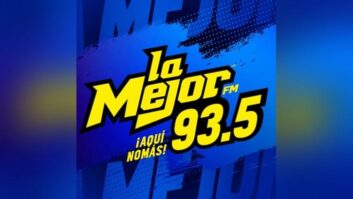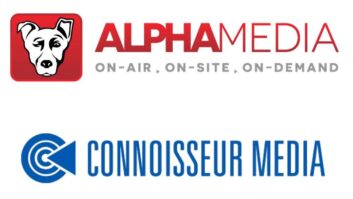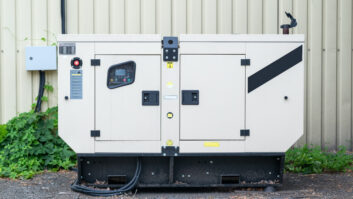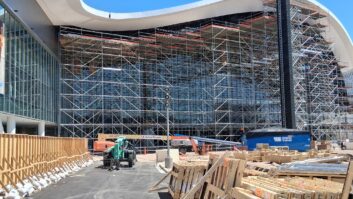We’ve recently heard and read in some trade publications about a growing number of stations losing coverage to new AM IBOC operations.
Many of the stories suggest that AM HD Radio stations may not be operating legally within the NRSC mask and are spilling over into adjacent channels, allegedly wiping out secondary coverage areas of complaining stations. IBOC detractors are reporting similar observations on Internet message boards.
This topic is top of mind across the industry, as the FCC is now pondering comments to the IBOC proceeding in Docket 99-325. Its conclusions will form the basis of the long-awaited transmission rules and standards for IBOC/HD Radio operations in the U.S.
WOR(AM) in New York has emerged as the poster-child of AM HD Radio and is being blamed for interfering with adjacent channel Long Island stations as well as WLW and WGN during the critical hours periods of sunrise and sunset. WOR’s Tom Ray, Buckley Broadcasting corporate director of engineering, has taken quite a bit of heat from the anti-IBOC crowd in spite of his squeaky clean technical operation that complies with NRSC limits. Lost in the din of criticism is the jaw-dropping improvement in service and performance that HD Radio offers for those who have heard it.
While there undoubtedly have been some early AM HD Radio stations testing and evaluating the new service – often with prototype gear that may not have met the mask limits on some occasions – the few HD Radio stations that are now on the air appear to be in compliance with the NRSC mask. Production model HD Radio exciters can easily achieve that.
These are stations that, in the main, are owned by larger groups that want to make dead sure they are operating properly and legally. Transmitter and exciter manufacturer engineers usually are on-site when these stations are turned up on HD Radio. Occupied bandwidth and NRSC compliance is verified with spectrum analysis proof.
The Real Story
Let’s break this interference issue down and understand what is really going on here.
Most of the AM HD interference complaints are being generated by the increase in the sustained sideband noise induced by the digital IBOC sideband carriers of an HD Radio station. While some of this energy is generated in the first adjacent channels in the form of secondary and tertiary sidebands, the primary digital sidebands generate the most, extending from 10 to 15 kHz from carrier into the bandpass of the second adjacent channel.
What many forget is that using this much bandwidth has always been permitted within the defined AM channel bandpass of FCC Rules and NRSC mask limits. Ibiquity is very much aware that the digital sidebands contain higher average energy than analog splatter and can become significant interference. Accordingly, it’s been proposing more restrictive specifications for the HD Radio transmissions mask that afford much more protection for third adjacent channel stations than currently required under FCC Rule 73.44.
WDMV (formerly WGOP), an AM daytimer on 700 kHz, is a typical example of a station recently impacted by digital interference. The station is located in Walkersville, Md., about 45 miles northwest of Washington, and is attempting to serve the greater Washington metro with most of the desired coverage well below its primary 5 mV/m contour strength.
WKDL(AM) on 730 kHz, operating HD Radio from Alexandria, Va., immediately south of Washington, has been blamed for interfering with WGOP’s secondary coverage contour that covers Arlington and parts of Alexandria.
Some of this apparent interference is actually caused by blanketing effects on analog receivers trying to listen to WDMV that are incapable of rejecting the much stronger carrier and lower sideband of WKDL. The digital sideband noise is also perceived as interference on radios that employ wider bandwidth IF and AF circuit designs when used outside pure blanketing conditions.
Deserving of protection?
Before WKDL turned on HD Radio transmissions, WDMV apparently claimed more useful secondary coverage into the southwest Washington area suburbs. But this was essentially unprotected coverage it was fortunate to have in a market the station is not licensed to serve. Expecting a half-millivolt signal to deliver acceptable reception on AM in noise-polluted population centers is a rather tenuous enterprise at best.
WKDL’s only real protection obligation to WDMV under present rules is meeting the limits of 73.44. WDMV’s 0.5 mV/m analog service contour is not reasonably afforded blanketing rule relief from the effects of digital noise from WKDL since that contour falls outside the 1000 mV/m blanketing contour of WKDL.
Sources close to Ibiquity have confirmed that WKDL has been operating HD Radio in compliance with NRSC limits.
All rim-shot stations trying to serve a larger market will undoubtedly experience apparent increased interference when a second or third adjacent channel station that is licensed to that larger community or a much closer suburb turns on HD Radio transmissions. Such stations will not have a basis for any FCC relief if the HD stations meet the mask requirements.
The commission cannot be expected to protect listeners outside protected contours or those using deficient or marginally designed receivers.
Meeting the Mask
Complying with 73.44 but also optimizing standards for HD Radio operations for the hybrid phase has been a work in progress for Ibiquity. Its challenge has always been to meet the NRSC mask while generating enough energy in the digital sidebands that extend right to the +/- 15 kHz limit of the AM channel to make HD Radio robust, but still afford reasonable protection to existing analog operations on nearby channels.
Ibiquity’s proposed HD Radio transmission limit rolls off very aggressively beyond 15 kHz from carrier, calling for -25 dBc at 15 kHz, -39 dBc at 15.8 kHz and -65 dBc from 15.8 to 30.5 kHz. The NRSC mask only requires -35 dBc attenuation from 20 to 30 kHz and does not require -65 dBc of suppression until 60 kHz from carrier.
This specification should benefit all potential third adjacent channel interference situations.
Clear Channel has reportedly been lobbying Ibiquity to reduce transmitted digital sideband energy an additional 6 dB. CC has quite a few 50 kW blowtorches that enjoy extensive fringe area and skywave nighttime listening the company feels need more protection from first and second adjacent channel digital stations.
So far, Ibiquity has not acquiesced to such a reduction in its most recent proposal. This could change.
Night Trains Ready to Roll
Beyond the issue of interference to fringe area coverage during daytime, we’ve been saying all along that deploying AM HD Radio at night is going to be a much stickier proposition during the transitional hybrid mode. Skywave reception of HD signals, especially in the East and Midwest, is going to cause problems for the secondary analog service areas of many first and second adjacent channel stations. Real nighttime coverage areas will shrink for many stations.
Despite the optimistic conclusions of the Ibiquity study completed to characterize digital nighttime interference profiles for all AM stations last year, a significant number of engineers and industry observers fear the band will be turned into a sea of hash at night when HD Radio is unleashed. Only the strong high-powered stations blessed with low NIF (nighttime interference free) limits may be able to maintain useful analog coverage inside those contours.
Even Ibiquity and NRSC engineers are unsure how digital reception of most HD Radio stations will fare at night in the presence of skywave digital interference. The so-called NIF protected contour may no longer be valid for most stations.
On one hand, AM operators see the promise of digital eventually improving their service by quantum leaps. On the other, they see the possibility of losing valuable amounts of nighttime and critical hours coverage during the hybrid transition mode.
AM stations are asking how much sacrifice they should make now in lost listening and revenue in the interests of attaining a more competitive and equitable future years down the road. Filing interference complaints involving fringe area reception could jeopardize the AM digital rollout if lots of stations choose to do so.
Case Load
The commission has established a preliminary procedure for handling interference complaints received during the rollout of daytime HD Radio operations. The agency is hoping stations can work out mutually agreed voluntary digital sideband power reductions of up to 6 dB to resolve their interference problems.
If agreement on some level of power reduction cannot be reached, formal complaints can be filed directly with the commission. The FCC has 90 days to order a course of action on each such filing.
If that doesn’t happen, the interfering station must reduce digital power by a full 6 dB. If that isn’t enough and problems linger, the commission can then order cessation of digital transmission for an interfering station.
The commission and the entire industry are wondering if this provision is working now and whether it would work at all for nighttime HD Radio interference mitigation. Will the FCC staff be ready to handle the potential tidal wave of such filings? And what other criteria and methods would it then use to determine and enforce the proper amount of imposed HD power reduction?
No matter what procedures are put into place, it’s liable to cause derailment of the entire digital rollout.
Let’s Be Reasonable
To prevent this from becoming a big-time train wreck, the commission could choose to suspend AM digital hybrid operations at night for all stations until the all-digital conversion for the entire band can be justified and mandated when HD Radio receivers sufficiently replace analog in the marketplace. Guy Wire suggested that option almost two years ago.
Or the commission might consider implementing a more restricted rollout of HD Radio at night, such as suggested by WGN(AM), Chicago in its comments to Docket 99-325. Authorize digital operations only between 5 a.m. and 7 p.m. to allow more time to evaluate actual propagation and interference effects during the critical hours especially during the first winter. This would at least let AM digital stations cover the vitally important drive-time periods pending consideration for any further relaxation.
When you look at the big picture, restricting digital at night should not be a deal-breaker for AM HD Radio since all stations can deploy it for daytime now. The receivers will be out there anyway assuming FM digital takes hold.
Let’s face it: The vast majority of listening that produces the lion’s share of revenue on virtually all successful radio stations occurs during daytime hours. Permitting AM HD Radio around the clock 24/7 should not be critically necessary for AM stations to reap significant benefit and advantage even if they only use it during the day.
Looking forward
Let’s assume the commission opens up HD Radio for unlimited hours or even the WGN-proposed schedule for all AM stations. Then after deploying digital, lots of stations are forced to reduce digital sideband power or turn it off altogether.
Many of them would probably not be happy with that mandate and would want to seek further relief. Might they be permitted to “buy down” or negotiate settlements with other affected stations to regain the ability to fully use HD Radio?
That would be significant for many older stations with low NIF limits that cause interference to many stations. Money could speak very loudly in such proceedings.
HD Radio deployment is poised to generate a good head of steam on the FM band, especially with the recent announcements committing Clear Channel and Entercom top-market stations to digital. When the first generation of HD Radio car radios start appearing as standard equipment in the 2005 model year, consumer interest and awareness will start to accelerate.
It’s really in the best interests of all AM stations to join the HD Radio train-ride when receiver sales become significant. The greater the number of stations that transmit in digital, the more likely and the more rapidly HD Radio receivers will supplant conventional receivers ensuring long-term success of the technology. This results in a shorter period the hybrid mode would be necessary.
Leaving analog AM behind and replacing it with all digital is really the ultimate prize that will free the AM band from the shackles of its noise-plagued, low-fidelity performance of the past 85 years. Most clear-thinking observers in this proceeding want to see the all-digital mode become reality sooner rather than later.
It is undeniable that the transitional hybrid mode, but especially the all-digital AM mode, stand to give the band and the service a huge shot in the arm, allowing parity with FM by almost every measure.







